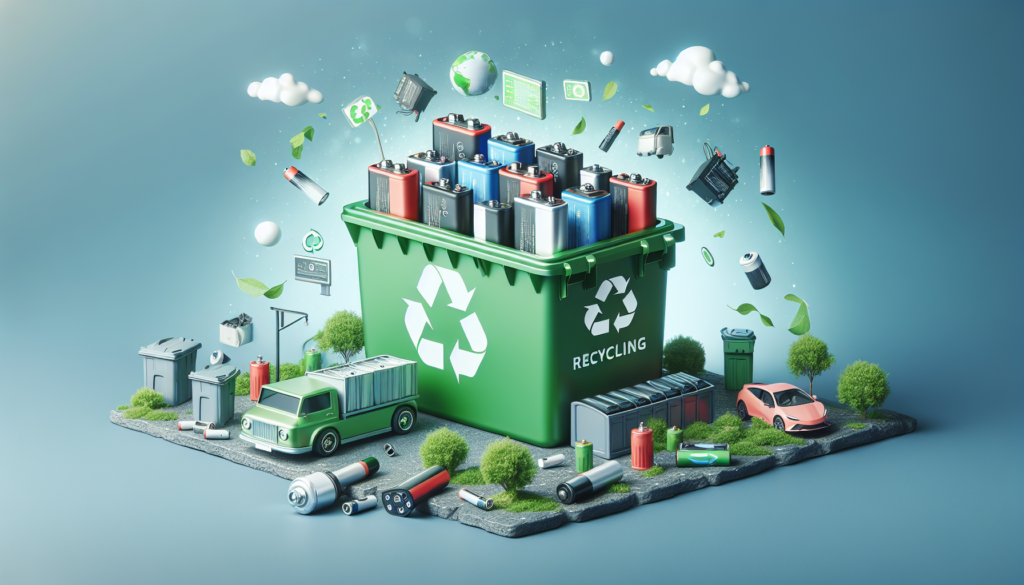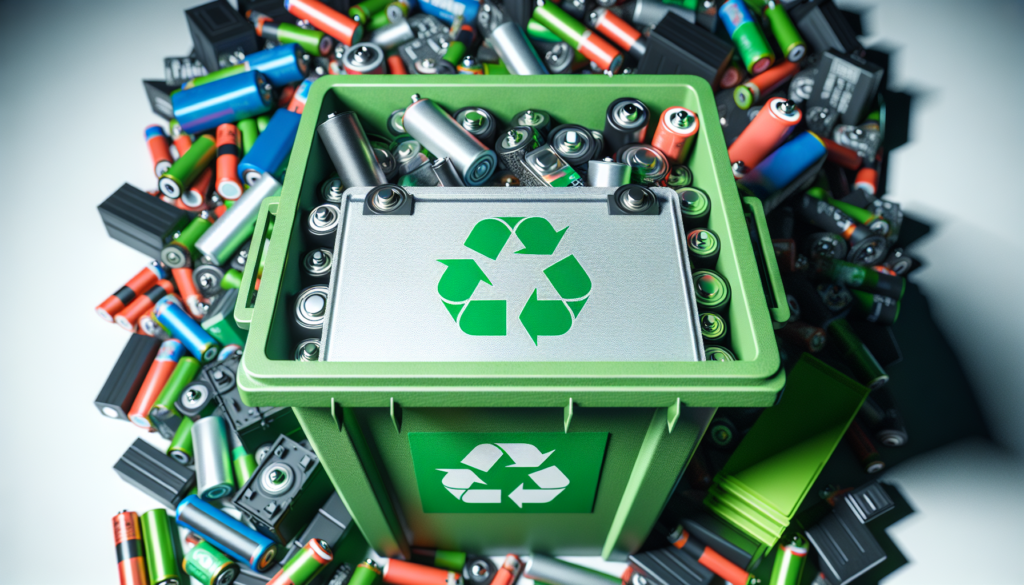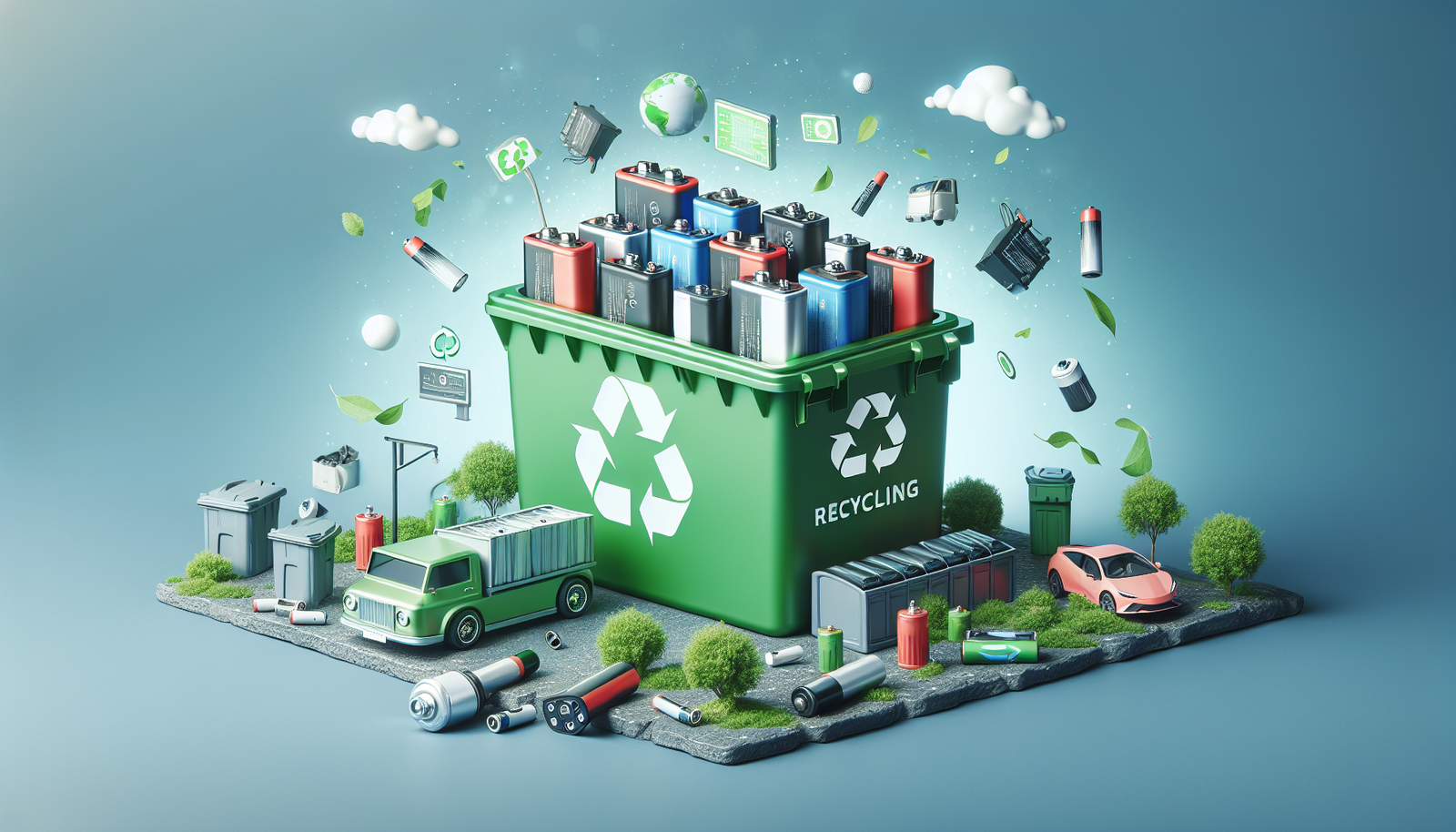Did you know that the rise in popularity of electric vehicles brings about an important question: what happens to their batteries when they reach their end of life? As electric vehicle adoption continues to grow, finding sustainable solutions for the disposal of these batteries becomes crucial. This article explores the various options and potential methods that can be utilized to dispose of old electric vehicle batteries in an environmentally-friendly manner, ensuring a greener future for our transportation industry.

Sustainable Disposal Options for Old Electric Vehicle Batteries
As the popularity of electric vehicles (EVs) continues to rise, it is important to address the issue of sustainable disposal for their old batteries. Luckily, there are various options available that promote environmentally-friendly practices while ensuring the safe disposal of these batteries. This article will explore these sustainable disposal options and delve into the different methods and approaches that can be utilized.
1. Battery Recycling
Importance of Recycling
Battery recycling plays a crucial role in mitigating the environmental impact of EV batteries. By recycling these batteries, valuable materials can be recovered and reused, reducing the need for extracting finite resources. Additionally, it helps prevent the release of harmful substances into the environment, such as heavy metals and toxic chemicals.
Recycling Process
The recycling process for old EV batteries typically involves several steps. Firstly, the batteries are collected and sorted at recycling facilities or dedicated collection centers. Then, they undergo a disassembly process, where the outer casing is removed, and the individual components are separated. After that, valuable materials like lithium, cobalt, and nickel are extracted through various refining techniques. These recovered materials can then be utilized to manufacture new batteries or other products.
Materials Recovered
One of the significant advantages of battery recycling is the recovery of valuable materials. Lithium, cobalt, nickel, and other precious metals can be extracted during the recycling process. These materials can be highly useful in producing new batteries or manufacturing other products, reducing the reliance on mining and minimizing the carbon footprint associated with their production.
Recycling Challenges
While battery recycling is a sustainable and beneficial approach, it is not without its challenges. The increasing demand for battery recycling means that there is a need for efficient and scalable recycling technologies. Additionally, the development of standardized recycling processes and regulations can ensure the responsible handling of EV batteries throughout their lifecycle.
2. Battery Repurposing
Benefits of Repurposing
Repurposing old EV batteries allows for their continued use in various applications, thereby extending their lifespan. These repurposed batteries can still retain a considerable amount of their original capacity, making them suitable for less demanding energy storage needs. By repurposing batteries, the demand for new batteries can be reduced, leading to fewer resources being consumed and less waste being generated.
Repurposing Methods
There are several ways to repurpose old EV batteries. Some common methods include utilizing them for stationary energy storage systems, such as those found in homes or businesses. These batteries can store excess energy generated from renewable sources, such as solar panels, and release it when needed. Other applications include providing power to rural or off-grid areas, supporting electric vehicle charging stations, and even powering small devices or appliances.
Limitations and Considerations
Although battery repurposing offers numerous benefits, there are limitations and considerations to be aware of. As batteries degrade over time, they may not be suitable for high-demand applications where reliability and performance are critical. Additionally, repurposing batteries requires careful monitoring and management to ensure they are safely used and do not pose any risks or hazards.
3. Battery Reuse
Advantages of Battery Reuse
Battery reuse involves taking old EV batteries and installing them into other electric vehicles. This practice helps maximize the lifespan and economic value of the batteries. By reusing batteries in different electric vehicles, the need for new batteries is significantly reduced, resulting in resource conservation and an overall decrease in environmental impact.
Second-Life Applications
Old EV batteries that no longer meet the demanding requirements of electric vehicles can still find utility in second-life applications. These batteries can be repurposed for less demanding tasks that do not require high-performance, such as energy storage for residential or commercial use. The ability to give these batteries a second life not only reduces waste but also creates opportunities for cost-effective energy storage solutions.
Challenges in Battery Reuse
While battery reuse presents numerous advantages, there are challenges that need to be addressed. Standardization and compatibility between different electric vehicle battery systems can be an obstacle, as each manufacturer may have their specific requirements and configurations. Additionally, battery management systems need to be accurately calibrated to ensure the safe and efficient use of reused batteries.

4. Responsible Disposal Methods
Importance of Responsible Disposal
In cases where recycling, repurposing, or reuse of EV batteries is not feasible or practical, responsible disposal is crucial to minimize the environmental impact. Responsible disposal involves adhering to proper handling, storage, and disposal methods to prevent any potential harm to the environment and human health. It is important to ensure that batteries are disposed of in designated collection centers or through certified programs.
Certified Collection Centers
Certified collection centers specialize in handling and managing the disposal of old EV batteries. These centers have the necessary equipment, expertise, and protocols to safely collect and store batteries until they can be properly recycled or disposed of. Utilizing certified collection centers ensures that batteries are handled responsibly, reducing the chances of hazardous materials entering the environment.
Proper Handling and Storage
When storing old EV batteries before their final disposal, it is essential to follow proper handling and storage procedures. This includes keeping the batteries in a dry and cool environment to prevent any possible leakage or damage. Additionally, ensuring that the batteries are stored in a secure area away from potential sources of ignition or other hazardous materials is crucial to minimize any safety risks.
Third-Party Disposal Services
Third-party disposal services offer comprehensive and specialized solutions for the responsible disposal of old EV batteries. These services typically handle the entire process, from collection and transportation to recycling or disposal. By utilizing these services, manufacturers, businesses, and individuals can be assured that their batteries are disposed of in accordance with regulations and environmental standards.
5. Extended Producer Responsibility Programs
Definition and Purpose
Extended Producer Responsibility (EPR) programs are regulatory frameworks that place the responsibility for managing and funding the disposal of products on the producers. In the context of EV batteries, EPR programs require manufacturers to take responsibility for the end-of-life management of their batteries. These programs aim to promote sustainable practices, encourage recycling, and reduce the burden on local waste management systems.
Implementation of EPR Programs
The implementation of EPR programs often involves establishing collection and recycling targets that manufacturers must meet. It also includes setting up systems for the proper collection and recycling of old EV batteries, either through designated collection centers or in partnership with recycling facilities. By enforcing EPR programs, manufacturers are incentivized to prioritize the sustainability of their products throughout their lifecycle.
Benefits and Challenges
EPR programs offer several benefits, including increased recycling rates and improved environmental outcomes. By placing responsibility on manufacturers, it encourages them to design products with greater longevity, recyclability, and fewer harmful components. However, implementing EPR programs can pose challenges, such as the need for effective monitoring and enforcement, as well as collaboration between manufacturers, regulators, and recycling facilities.

6. Laws and Regulations
National and International Regulations
Various national and international regulations exist to govern the disposal of old EV batteries. These regulations aim to protect the environment and human health by ensuring safe and responsible handling throughout their lifecycle. Organizations such as the European Union (EU) have established directives that outline specific requirements for the collection, treatment, and recycling of batteries to minimize their environmental impact.
Recycling Targets and Compliance
To further promote sustainable disposal practices, many countries have implemented recycling targets for EV batteries. These targets incentivize manufacturers to meet specific recycling rates, ensuring that a certain percentage of batteries are recycled rather than being disposed of in landfills or incinerated. Compliance with these targets is essential to create a circular economy for EV batteries and prevent unnecessary waste.
Environmental Standards
Environmental standards play a key role in ensuring that the disposal and recycling of old EV batteries are conducted in an environmentally sound manner. These standards outline the specific requirements and protocols for safe handling, storage, and recycling processes to mitigate any adverse impacts on the environment. Adhering to these standards helps protect ecosystems and reduce the potential health risks associated with improper disposal.
7. Innovative Technologies
Battery-to-Battery Recycling
Battery-to-battery recycling technologies aim to extract valuable materials from old EV batteries and reuse them in the production of new batteries. These innovative methods help conserve resources by minimizing the reliance on raw materials and reducing waste. By recovering materials like lithium, cobalt, and nickel, battery-to-battery recycling contributes to the sustainability of the battery industry.
Hydrometallurgical Methods
Hydrometallurgical methods involve the use of chemical processes to recover valuable materials from old EV batteries. These methods typically utilize solvents or acids to dissolve and extract specific metals, which can then be refined and reused. Hydrometallurgical processes are advantageous as they can recover a wide range of metals, but they require careful management to prevent any environmental contamination.
Pyrometallurgical Methods
Pyrometallurgical methods involve the use of high heat to smelt and separate metals from old EV batteries. Through this process, metals can be melted and separated based on their different melting points. Pyrometallurgical methods are effective in recovering metals like cobalt and nickel but require specialized equipment and careful emissions management to mitigate any environmental impacts.
Biotechnological Approaches
Biotechnological approaches are emerging as a sustainable method of extracting valuable materials from old EV batteries. These methods involve the use of microorganisms or enzymes to selectively recover specific metals from battery components. Biotechnological approaches offer the advantage of being environmentally friendly and energy-efficient, with the potential to revolutionize battery recycling processes in the future.

8. Collaboration between Manufacturers and Recycling Facilities
Importance of Collaboration
Collaboration between manufacturers and recycling facilities is crucial to establish effective and sustainable recycling systems. By working together, manufacturers can ensure that their batteries are designed with recyclability in mind, making the recycling process more efficient and cost-effective. Collaborating with recycling facilities also allows manufacturers to gain insights into the latest recycling technologies and processes.
Design for Recycling
Designing products for recycling involves incorporating features that enhance the recyclability of battery components. Manufacturers can optimize the disassembly process, minimize the use of hazardous materials, and ensure that materials are easily separable during recycling. By designing batteries with recycling in mind, the entire lifecycle of the battery can be more sustainable.
Establishing Collection Networks
Manufacturers can collaborate with recycling facilities to establish collection networks that facilitate the proper disposal and recycling of old EV batteries. These networks can consist of dedicated collection centers, drop-off locations, or partnerships with existing waste management systems. Establishing accessible and convenient collection methods helps ensure that batteries are disposed of responsibly and can be efficiently recycled.
Research and Development Partnerships
Collaboration between manufacturers and recycling facilities also extends to research and development partnerships. These partnerships foster innovation and the development of new recycling technologies, making the recycling process more efficient and effective. By sharing knowledge and resources, manufacturers and recycling facilities can work together to address challenges and find sustainable solutions for the recycling of old EV batteries.
10. Public Awareness and Education
Educating Consumers
Educating consumers about the importance of sustainable disposal options for old EV batteries is vital in encouraging responsible behavior. By raising awareness about recycling, repurposing, and proper disposal methods, consumers can make informed choices and actively contribute to environmental preservation. Manufacturers and government authorities can play a crucial role in providing educational materials and campaigns to inform consumers about their options.
Promoting Sustainable Practices
Promoting sustainable practices includes encouraging the adoption of recycling and repurposing methods for old EV batteries. This can be done through incentive programs, such as offering discounts or credits for returning used batteries or using recycled materials in new products. By creating a supportive environment for sustainable practices, individuals are more likely to actively engage in responsible disposal methods.
Raising Awareness of Recycling Options
Many individuals may be unaware of the recycling options available for old EV batteries. Raising awareness about battery recycling programs, collection centers, and the benefits of recycling can motivate individuals to participate in these initiatives. Utilizing various communication channels like social media, websites, and educational campaigns can effectively disseminate information and increase public engagement.
Encouraging Responsible Ownership
Encouraging responsible ownership means emphasizing the importance of properly disposing of old EV batteries when they reach the end of their useful life. This includes informing individuals about the potential hazards associated with improper disposal and the benefits of utilizing sustainable disposal options. By promoting responsible ownership, the entire lifecycle of EV batteries can be managed in an environmentally-conscious manner.
In conclusion, sustainable disposal options for old electric vehicle batteries are vital in mitigating the environmental impact of these batteries. Battery recycling, repurposing, and reuse, along with responsible disposal methods, are all essential approaches to ensure the proper management of these batteries. With the implementation of extended producer responsibility programs, collaboration between manufacturers and recycling facilities, and public awareness and education, we can create a more sustainable future for the EV battery industry.


